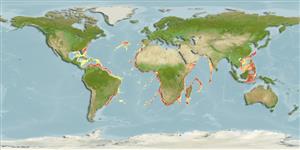Elasmobranchii (sharks and rays) >
Squaliformes (Sleeper and dogfish sharks) >
Centrophoridae (Gulper sharks)
Etymology: Deania: -ia (Gr.), belonging to: American ichthyologist Bashford Dean (1867-1928), American Museum of Natural History, for his research on selachian fishes (See ETYFish); profundorum: Latin for “of the depths,” type specimens collected from 717-1785 m (See ETYFish).
Eponymy: Dr Bashford Dean (1857–1928) was an American zoologist, ichthyologist and acknowledged expert on mediaeval armour. [...] (Ref. 128868), visit book page.
More on authors: Smith & Radcliffe.
Environment: milieu / climate zone / depth range / distribution range
Ecology
Marine; bathydemersal; depth range 205 - 1800 m (Ref. 55584). Deep-water; 40°N - 37°S, 93°W - 127°E (Ref. 54348)
Northwest Atlantic: North Carolina, USA. Eastern Atlantic: West Sahara to Senegal, Nigeria, Gabon to Democratic Republic of the Congo, Namibia and South Africa (Ref. 5578). Indian Ocean: Arabian Sea (Ref. 85183). Western Central Pacific: Philippines.
Length at first maturity / Size / Weight / Age
Maturity: Lm ?, range 70 - ? cm
Max length : 110 cm TL male/unsexed; (Ref. 95232)
Dorsal spines (total): 2; Anal spines: 0. A longnose dogfish with a long, low 1st dorsal fin and a subcaudal keel on underside of caudal peduncle (Ref. 5578). Brownish-grey or dark grey in color (Ref. 5578).
Found on the upper continental and insular slopes, on or near the bottom (Ref. 247). Feeds on small benthic and midwater bony fishes, squid, and crustaceans (Ref. 247). Ovoviviparous (Ref. 50449). Minimum depth reported from taken from Ref. 5578.
Ovoviviparous, embryos feed solely on yolk (Ref. 50449). 5 to 7 young in a litter (Ref. 5578). Distinct pairing with embrace (Ref. 205).
Compagno, L.J.V., 1984. FAO Species Catalogue. Vol. 4. Sharks of the world. An annotated and illustrated catalogue of shark species known to date. Part 1 - Hexanchiformes to Lamniformes. FAO Fish. Synop. 125(4/1):1-249. Rome, FAO. (Ref. 247)
IUCN Red List Status (Ref. 130435: Version 2024-1)
Threat to humans
Harmless
Human uses
Fisheries: of no interest
Tools
Special reports
Download XML
Internet sources
Estimates based on models
Preferred temperature (Ref.
123201): 4.9 - 12.3, mean 8.3 °C (based on 337 cells).
Phylogenetic diversity index (Ref.
82804): PD
50 = 0.5625 [Uniqueness, from 0.5 = low to 2.0 = high].
Bayesian length-weight: a=0.00191 (0.00109 - 0.00333), b=3.17 (3.01 - 3.33), in cm total length, based on LWR estimates for this species & (Sub)family-body (Ref.
93245).
Trophic level (Ref.
69278): 4.4 ±0.4 se; based on diet studies.
Resilience (Ref.
120179): Very Low, minimum population doubling time more than 14 years (Fec=5).
Fishing Vulnerability (Ref.
59153): High to very high vulnerability (66 of 100).
Nutrients (Ref.
124155): Calcium = 7.85 [1.60, 42.16] mg/100g; Iron = 0.322 [0.076, 1.053] mg/100g; Protein = 20.7 [17.7, 22.9] %; Omega3 = 0.33 [0.12, 1.04] g/100g; Selenium = 15.9 [4.8, 45.8] μg/100g; VitaminA = 15.3 [3.4, 70.3] μg/100g; Zinc = 0.288 [0.139, 0.564] mg/100g (wet weight);
